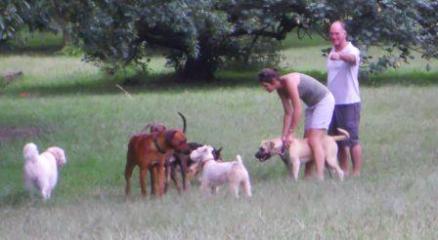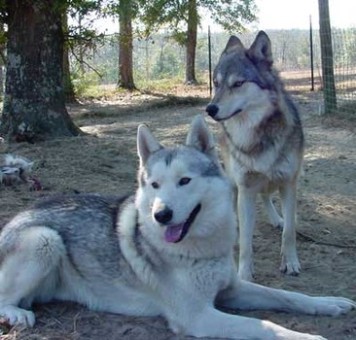 I walk my dogs regularly in our local off-leash dog park. There are, inevitably, the odd squabbles but these confrontations are usually more noise and posturing than anything else, and these incidents are pretty infrequent. Just recently, however, a specific group of dogs are displaying pack and predatory behaviour towards the other dogs, and this is concerning me because I do not see a positive outcome.
I walk my dogs regularly in our local off-leash dog park. There are, inevitably, the odd squabbles but these confrontations are usually more noise and posturing than anything else, and these incidents are pretty infrequent. Just recently, however, a specific group of dogs are displaying pack and predatory behaviour towards the other dogs, and this is concerning me because I do not see a positive outcome.
The group of dogs all belong to the same family and are wolf-hybrids who started coming to the park as puppies for socialization with other dogs and people. They are now adults and up until recently I was not too concerned as in spite of their early experiences in the park they were not engaging socially with the other dogs were rather aloof. My own recent experience with these dogs has not been pleasant and I have observed behaviour that I’m not entirely comfortable with.
On the particular occasion that drew my attention to the behaviour of this group I had just arrived with my three Labrador retrievers. My young 18 month old girl in her excitement was “prancing” around excitedly. She drew the attention of the group of dogs in question, and without any prompting they all, in unison, advanced on her and started tackling her. I immediately interceded and managed to get her away but not before she had been bitten on her rump. Fortunately there were no puncture wounds, but she was tender for a couple of days after that so there must have been bruising. My young dog has been very well socialized with other dogs from a very early age and until this incident has not displayed any fearful behaviour on being approached by another dog or dogs. Her recognition of the threatening behaviour of the approaching “pack” was immediate and something that I’d never seen before.
Yesterday I arrived at the dog park (three weeks or more after the incident I have just described) and on getting out of my truck, my young lab noticed the same group of dogs that had tackled her before. She immediately displayed signs of fear – tail tucked, ears back and hiding behind me. Unfortunately they also spotted her and her body language obviously attracted them as they advanced with a predatory “stare”. She, of course, turned to run so I placed myself between her and the advancing dogs. Fortunately, they backed off and I could continue with my walk – the whole time making sure I avoided the “pack”. My poor young dog spent the entire walk scanning the environment for the “pack” and did not enjoy the walk at all.
This got me thinking about predation, aggression and predatory drift.
Predation is associated with food acquisition whereas aggression is associated with either competition for a resource or as a defensive coping mechanism. Predatory behaviour needs careful attention because the results are more often extremely damaging than the results of routine defence and competition. The behaviour I have been seeing in the park from the group of dogs I’m discussing is a frank display of predatory behaviour – the same behaviour they would display towards a cat, or rat or other prey animal. Fortunately the behaviour is always interrupted so thankfully has never been concluded but anyone who walks their dogs in the park whenever these particular dogs are present should be aware of the signals they are sending and prevent their dog coming too close. The predation is often triggered by obviously fearful or submissive behaviour by the “targeted” dog and can be exacerbated by vocalizations such as squealing.
Predatory Drift (a term coined by Dr Ian Dunbar), unlike regular predation which is identifiable as such from the beginning of the behaviour chain, is the triggering of predatory reflexes in an interaction that often begins as a social interaction by a dog that has never been predatory before and may never be again. The triggers are very specific contextually. Some of the situations that might lead to predatory drift are:
- Play between two dogs of different size. If play between a large dog and a small dog results in the smaller dog yelping and struggling this could appear to the large dog very much like a prey item rather than a playmate and the roles would drift from social interaction to predator-prey. The bigger the difference in size the more likely it is that in this situation, the damage to the smaller dog could be fatal, particularly if the small dog is grabbed and shaken.
- A couple or more dogs ganging up against a single dog in a chase or mock scrap scenario could also lead to predatory drift, particularly if the “victim” starts panicking or trying to escape by running. Very often, also, two dogs chasing a single dog will attract other dogs that are observing and pull them into the interaction as well, with disastrous consequences for the single dog.
The question that should be asked is how is all this connected with dogs having a play session. There are six specific behaviours that may be included in dog play and these are all part of the predatory motor pattern. Stare or Orient; Stalk; Chase; Nip; Grab. Dog play could involve all of these or just some of them. The chase and grab is one I see often with my dogs, but I have also seen other dogs grab a toy and shake it vigorously. Stalk and chase behaviour is also a popular game with dogs.
Because dogs share the same genes as wolves, jackals, coyotes and dingoes, they also share the same predatory programming although because of natural and artificial selection, these programmes have been modified. Dog play exhibits most of the elements of the hunt that we see in our dog’s wild cousins. We can also see how easy it would be for the play behaviours to “drift” over into predation.


Hi Louise
Thanks for this! While we were at the trials in the Transvaal, my other Golden Retriever (Sebastian) was attacked at a park near our home, while walking with my daughter in law. I could not understand why, because he is such a soft natured dog never showing aggression, and usually is able to run away. This time he was not so lucky, and after being attacked by this Great Dane (who was walking with a mini Schnauzer), he had to be operated on. After reading your “post”, I can now visualize how and why it happened.
On Mothers Day I took him for a walk at the same park and there were a pack of about 12 dogs, belonging to one man. As we walked past I saw Sebastian looking scared, head down and trying to go around them, but they went for him! Luckily he survived with a few scrape wounds. From your post I now realise why he is being attacked, but this is difficult to prevent happening again and again!
Regards
Marian van Wyk
LikeLike
Same thing happened to my lab. Stalked by huge dog and started to fight. My dog is a big teddybear and since has been wary of dogs. We don’t go to dog park anymore. The owners do not watch and control their dog as they are chatting away.
LikeLike